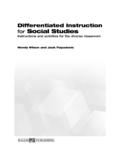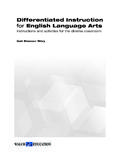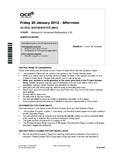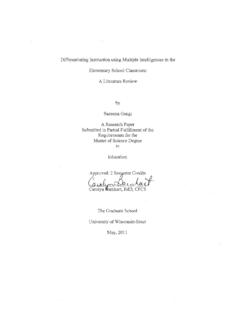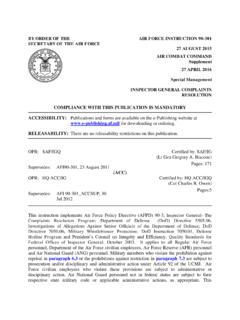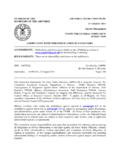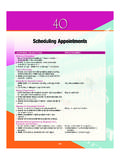Transcription of Differentiated Instruction in Elementary Social …
1 Social Studies Research and Practice 112 Volume 7 number 2 Winter 2012 Differentiated Instruction in Elementary Social Studies: Where Do Teachers Begin? Kay A. Chick Barbara S. S. Hong Penn State Altoona This paper presents the philosophy and goals of Differentiated Instruction in the Social studies. Children s literature is incorporated to highlight five practical and easy-to-implement strategies for differentiating Instruction . These strategies are presented to assist teachers in meeting the needs of a diverse student population. Differentiated Instruction is emphasized in ways that help students experience the benefits of a democratic Social studies classroom where the responsibility for learning is shared. Key words: Differentiated Instruction , Social studies, democratic classrooms, instructional strategies, diversity, children s literature Introduction Effective teachers adapt Instruction to meet the needs of individual learners.
2 Differentiated Instruction , otherwise known as responsive Instruction , is a philosophy that encourages teachers to modify curriculum, instructional strategies, and student products based on the readiness levels, interests, and learning profiles of individual students. Effective teachers of Social studies incorporate a variety of techniques in the Instruction , assessment, and grouping of students because not everyone learns the same thing at the same time with the same approach (Tomlinson, 1999). By proactively identifying the needs of each student, teachers are better able to make decisions regarding curriculum adaptation, instructional design, instructional tools integration ( , computer, graphic organizers, visual aids, and cues), and data interpretation (Lovin, Kyger, & Allsopp, 2004).
3 The ultimate goal of Differentiated Instruction in the Social studies classroom is to help all students experience success, regardless of their learning capabilities. A secondary goal of Differentiated Instruction in the Social studies is for students to experience a democratic classroom where the responsibility for learning is shared. In such a classroom, students have choices and discover strategies that will help them to become more independent learners. They begin to ask important questions, collaborate with teachers on big ideas to pursue, and become classroom leaders who provide insight into their interests, abilities, and learning styles. Some of the responsibility for meeting students needs shifts to the learners themselves (Waterman, 2007).
4 The shift brings increases in motivation, independence, and opportunity for democracy in action, where students are members of learning communities (Westphal, 2007). Creating successful learning opportunities for all learners can be a daunting task. In many Social studies classrooms there are students who represent a wide range of ability and reading levels. Students with disabilities often are included in general education classrooms for Social studies Instruction and may require significant adaptations in curriculum, Instruction , assessment, Social Studies Research and Practice 113 Volume 7 number 2 Winter 2012 and classroom organization. Such adaptations require constant reflection, as teachers talk to themselves and get feedback from their students about what works and what doesn t.
5 Some teachers, especially novices, are so focused on the basics of curriculum and Instruction that they fail to reflect on the overall learning environment of the classroom, the specific needs of learners, or the value of shared responsibility. They may be concerned about students who are passive learners with less than stellar memories and limited learning strategies, but are hesitant as to how to help students meet learning targets (Bender, 2008). If lessons are planned according to the standard grade curriculum, the results limit opportunities for authentic learning and student choice. Another concern of teachers is that with time constraints and curriculum mandates, Social studies Instruction often is forgotten. Integrating children s literature into the Social studies allows teachers to promote literacy skills while teaching to Social studies standards.
6 Children s literature can enrich opportunities for differentiation in student products based on learners interests, abilities, and learning styles. While picture books are ideally suited for students in the primary grades, they also are useful for increasing learning opportunities for intermediate grade students, beyond those who are reading below grade level. Picture books can easily climb grade levels by offering students the opportunity to critique, analyze from multiple perspectives, and springboard into discussion of complex issues (Shea, 2010, p. 35). According to Shea, picture books beg to be used up and down the grades and across the curriculum, and even the simplest picture books can be profound when examined through the various lenses of literary criticism (Shea, 2010, p.)
7 34). Strategies for Differentiating Instruction The following five practical and easy-to-implement strategies can help teachers of the Social studies to meet the needs of all students, while also allowing learners to experience the benefits of a democratic classroom. To demonstrate methods for creating Differentiated learning opportunities and questioning strategies, we base our examples on the picture book, Climbing Lincoln s steps: The African American journey (Slade, 2010), a National Council for the Social Studies (NCSS) trade book selection for 2011. This book highlights great moments in African American history that took place at the Lincoln Memorial and describes the impact these events had on the civil rights movement. The book includes illustrations encouraging students to make meaning from visual sources, in addition to the text.
8 The Differentiated learning activities presented here are designed for students in grades three through five but can be adapted for other grades. Big Paper: Building a Silent Conversation The Big Paper strategy helps students use writing and silence to explore significant topics and issues by providing time to think deeply and consider the views of others. After reading aloud Climbing Lincoln s steps: The African American journey (Slade, 2010), the teacher assists students in forming mixed-ability groups with three to four students per group. Each group is provided with a sheet of poster paper and enough markers for each student. Students use the poster paper to have a 15 minute silent conversation by making written comments about the issues in the book and asking questions of each other.
9 They respond in writing to each other s comments and questions and all group members write at the same time. Lines can be drawn to connect comments and questions and the silent conversation can go in any direction of the Social Studies Research and Practice 114 Volume 7 number 2 Winter 2012 group s choosing. When time is up, groups move around the room and react silently by writing reactions on other groups Big Papers. Each group then meets back at their own Big Paper and the silence ends. Group members are encouraged to have conversations about the book, the written comments, and any issues or questions that arise. Wrap-up can include large group conversation about the book, the strategy, and what they learned (Facing History and Ourselves, 2012).
10 Identity Charts An alternative to Big Paper (Facing History and Ourselves, 2012) is Identity Charts, graphic tools that allow learners to consider the identity, personality, and contributions of historical figures (Facing History and Ourselves). The names of all the historical figures in Climbing Lincoln s steps: The African American journey (Slade, 2010), such as Abraham Lincoln, Marian Anderson, and Barack Obama, are placed in a container. After students get in flexible groups of three to four students, each group selects a name from the container. The group places that name in the center of a large piece of poster board. Students then brainstorm to discover who this person is, what words describe the person, and what role he or she played in history.






